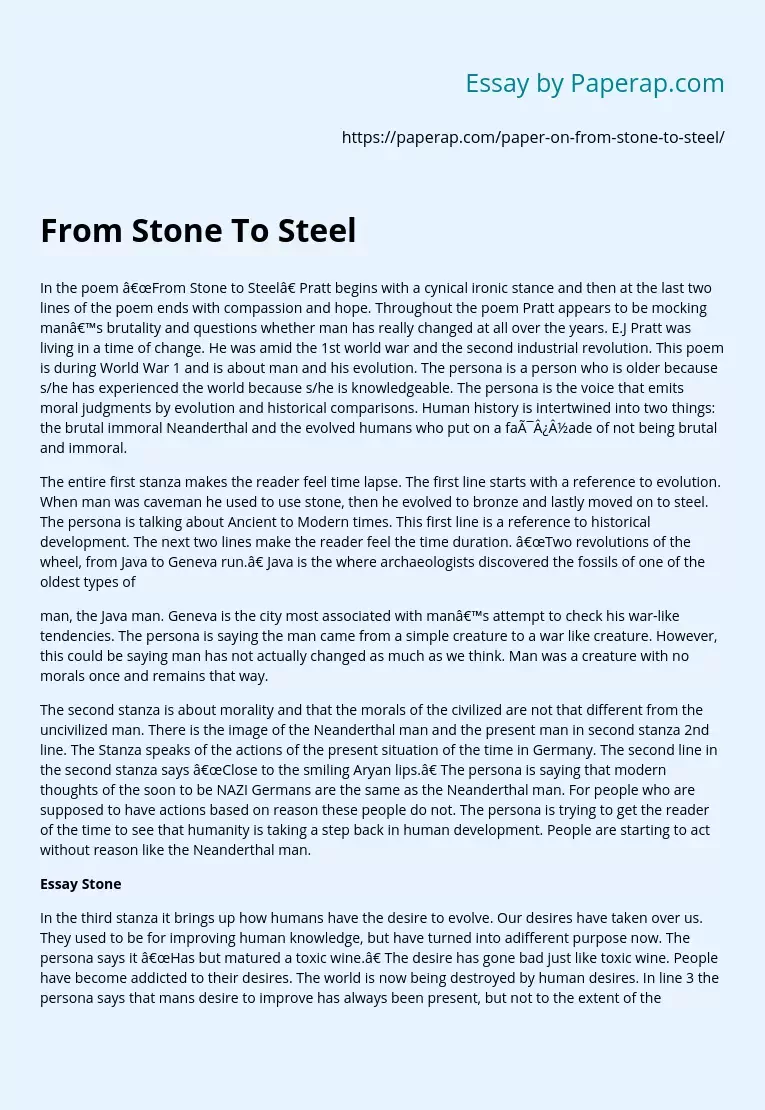From Stone To Steel E.J Pratt's Poem Analysis
In the poem “From Stone to Steel” Pratt begins with a cynical ironic stance and then at the last two lines of the poem ends with compassion and hope. Throughout the poem Pratt appears to be mocking man’s brutality and questions whether man has really changed at all over the years. E.J Pratt was living in a time of change. He was amid the 1st world war and the second industrial revolution. This poem is during World War 1 and is about man and his evolution.
The persona is a person who is older because s/he has experienced the world because s/he is knowledgeable. The persona is the voice that emits moral judgments by evolution and historical comparisons. Human history is intertwined into two things: the brutal immoral Neanderthal and the evolved humans who put on a fa�ade of not being brutal and immoral.
Detailed Analysis of the Text
The entire first stanza makes the reader feel time lapse.
The first line starts with a reference to evolution. When man was caveman he used to use stone, then he evolved to bronze and lastly moved on to steel. The persona is talking about Ancient to Modern times. This first line is a reference to historical development. The next two lines make the reader feel the time duration. “Two revolutions of the wheel, from Java to Geneva run.” Java is the where archaeologists discovered the fossils of one of the oldest types of
man, the Java man. Geneva is the city most associated with man’s attempt to check his war-like tendencies.
The persona is saying the man came from a simple creature to a war like creature. However, this could be saying man has not actually changed as much as we think. Man was a creature with no morals once and remains that way.
The second stanza is about morality and that the morals of the civilized are not that different from the uncivilized man. There is the image of the Neanderthal man and the present man in second stanza 2nd line. The Stanza speaks of the actions of the present situation of the time in Germany. The second line in the second stanza says “Close to the smiling Aryan lips.” The persona is saying that modern thoughts of the soon to be NAZI Germans are the same as the Neanderthal man. For people who are supposed to have actions based on reason these people do not. The persona is trying to get the reader of the time to see that humanity is taking a step back in human development. People are starting to act without reason like the Neanderthal man.
In the third stanza it brings up how humans have the desire to evolve. Our desires have taken over us. They used to be for improving human knowledge, but have turned into adifferent purpose now. The persona says it “Has but matured a toxic wine.” The desire has gone bad just like toxic wine. People have become addicted to their desires. The world is now being destroyed by human desires. In line 3 the persona says that mans desire to improve has always been present, but not to the extent of the present day. The persona proves his point saying it is desire that reddened Euphrates or Rhine. The Jews wanted to evolve into there own people.
The fourth stanza is about religion and that the cave man still. “Between the temple and the Cave.” The boundary between the two is very small. The cave is not very different from the temple. Humans are civilized, moral and religious, but ironically they still get satisfaction out of sin. This must mean man really has not changed all that much over the years. In the fourth stanza the persona’s outlook becomes very religious. The persona is saying the road after death can either go up to heaven or down to hell. Regardless if you are one of the earliest men (Neanderthal) or present man. Even if you are the church or a king the path lies through Jesus and the sacrifice he did for all man kind. “The path lies through Gethesmane”, this is the place where Jesus was crucified.
There is a cheerful iambic rhythm until the last two lines simultaneously slow the rhythm which was not done in other areas of the poem. The poem consists of assonance. The best example would be the first line. Vowels are repeated in the third letter of every word and are mostly ‘o’. There is a masculine rhyme in the poem. The rhyme scheme is dede.
This poem shows the brutality of human history. Neanderthal contrasts the image of the present man with the brutal Neanderthal. There is a great deal of religious imagery in the poem. “The Reddened Euphrates” this was the river that Mosses turned to blood in the plagues of Egypt. Geneva and Java are both images of human history and development. Toxic wine and drunk are also images. The wine is the horrible state of things. Drunk represents the symbol of the effects of wine that have always been present in time.
This poem lets the reader sit back and think about human evolution. The poem raises many questions about the evolution of man. The poem asks has man really evolved or is man still brutal, do we hide it with our fa�ade of morals and spirituality. The persona does believe though there is an answer, the truth lies down the road of Heaven.
From Stone To Steel E.J Pratt's Poem Analysis. (2019, Dec 05). Retrieved from https://paperap.com/paper-on-from-stone-to-steel/

